Bibimbap Sauce (Korean Gochujang Sauce)
This traditional Korean bibimbap sauce recipe delivers pure umami in no time. The sweet and spicy gochujang sauce is perfect for homemade bibimbap. Or drizzle it over any rice or grain bowl. It also happens to be vegan and gluten-free.
Traditional Korean bibimbap sauce is spicy, sweet, a little nutty and flavour-packed – the perfect condiment to elevate a simple bowl of rice.
I instantly fell in love with Korean food after my first bite of dolsot bibimbap with its spicy gochujang sauce at our local Korean restaurant.
This delicious bibimbap sauce recipe is super easy to follow. Use it for bibimbap (Korean rice bowls), drizzle it over buddha bowls or noodles, serve it as a spicy dipping sauce, or enjoy it as hot sauce over every meal.
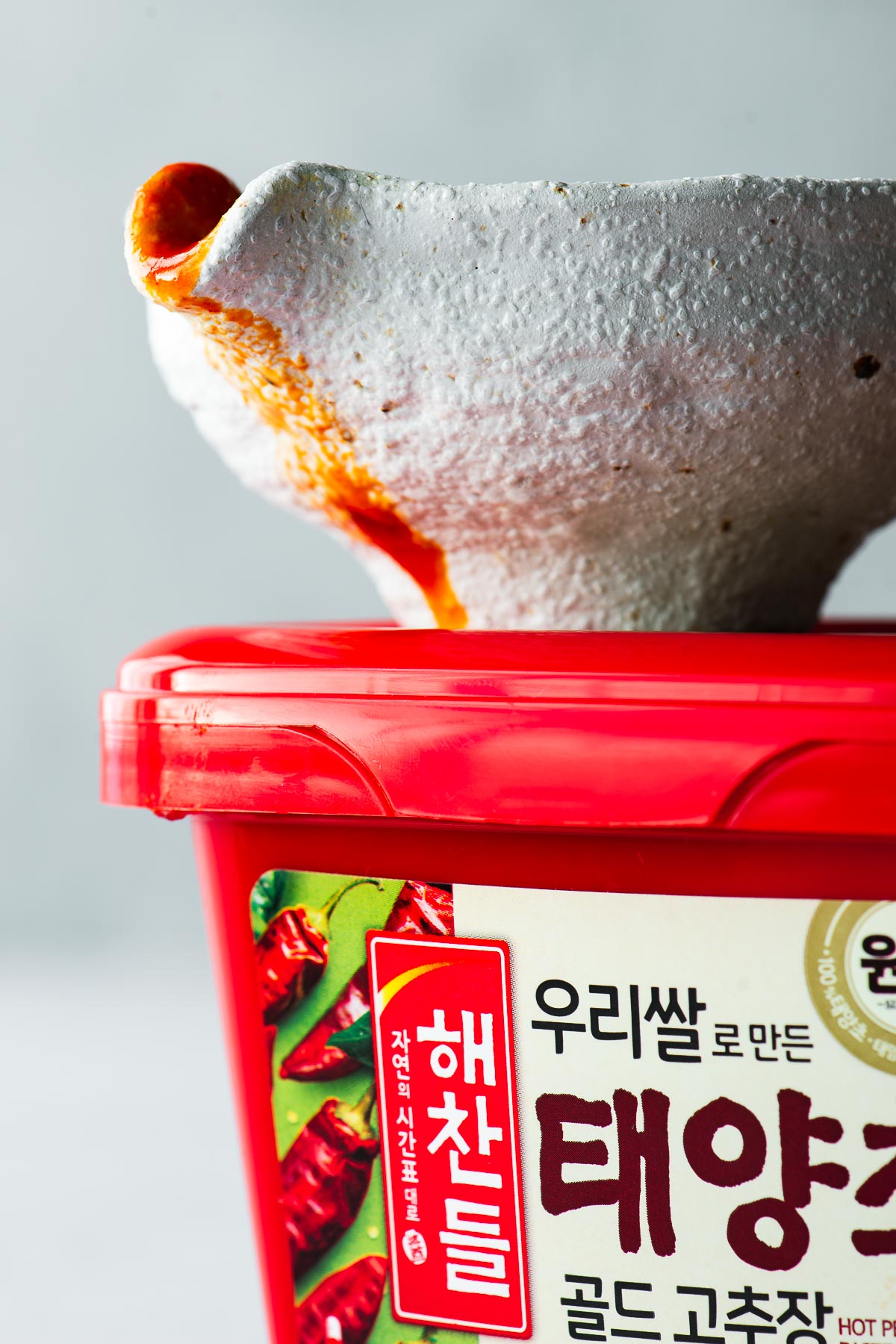
Why I love this sauce
You can find shop-bought gochujang sauce for bibimbap in Asian grocery stores. The typical packaging is a red squeeze bottle (not to be confused with the red tub of gochujang paste).
You may wonder, why not just stick to the shop-bought version?
- Homemade gochujang sauce is ridiculously easy to make and requires very few ingredients.
- Store-bought gochujang sauce can contain cane sugar, corn syrup, preservatives and stabilisers.
Making homemade gochujang sauce is a no-brainer for me.
What is bibimbap?
Bibimbap (also bi bim bap or bi bim bop) is a popular Korean rice dish. It is a bowl of white rice topped with individually seasoned and sautéed vegetables, kimchi and bibimbap sauce (most commonly gochujang sauce, but also doenjang sauce). Toppings can also include raw egg yolk, fried egg, or slices of meat.
Bibim means to mix, and bap refers to rice. When serving bibimbap, you mix your rice, toppings and sauce at the dining table.
In Korea, the bibimbap variations are endless. Different regions have different preferences for toppings and sauce ingredients.
Dolsot bibimbap (hot stone pot bibimbap) is a variation served in a sizzling hot stone bowl (dolsot). The hot stone cooks the rice at the bottom of the bowl to a golden crisp. Then you mix those crispy bits and cooked rice with the toppings and sauce at the dining table.
What makes Korean bibimbap so delicious?
It’s simple – the bibimbap sauce! It delivers that unique Korean flavour in a sweet, savoury, umami-packed package.
Traditional bibimbap sauce can have gochujang (Korean chilli paste) or doenjang (Korean fermented bean paste) as the sauce base. The most common sauce additions are minced garlic, toasted sesame oil, honey, sugar, rice vinegar, salt, or soy sauce.
I prefer gochujang sauce for my bibimbap. And gochujang is already flavour-packed, so it does not need much to turn it into an umami flavour sensation.
This simple gochujang sauce is all you need for a bowl of rice. It is bold, spicy, sweet, and salty – an embodiment of Korean cooking.
Read more about gochujang paste and the best substitutes.
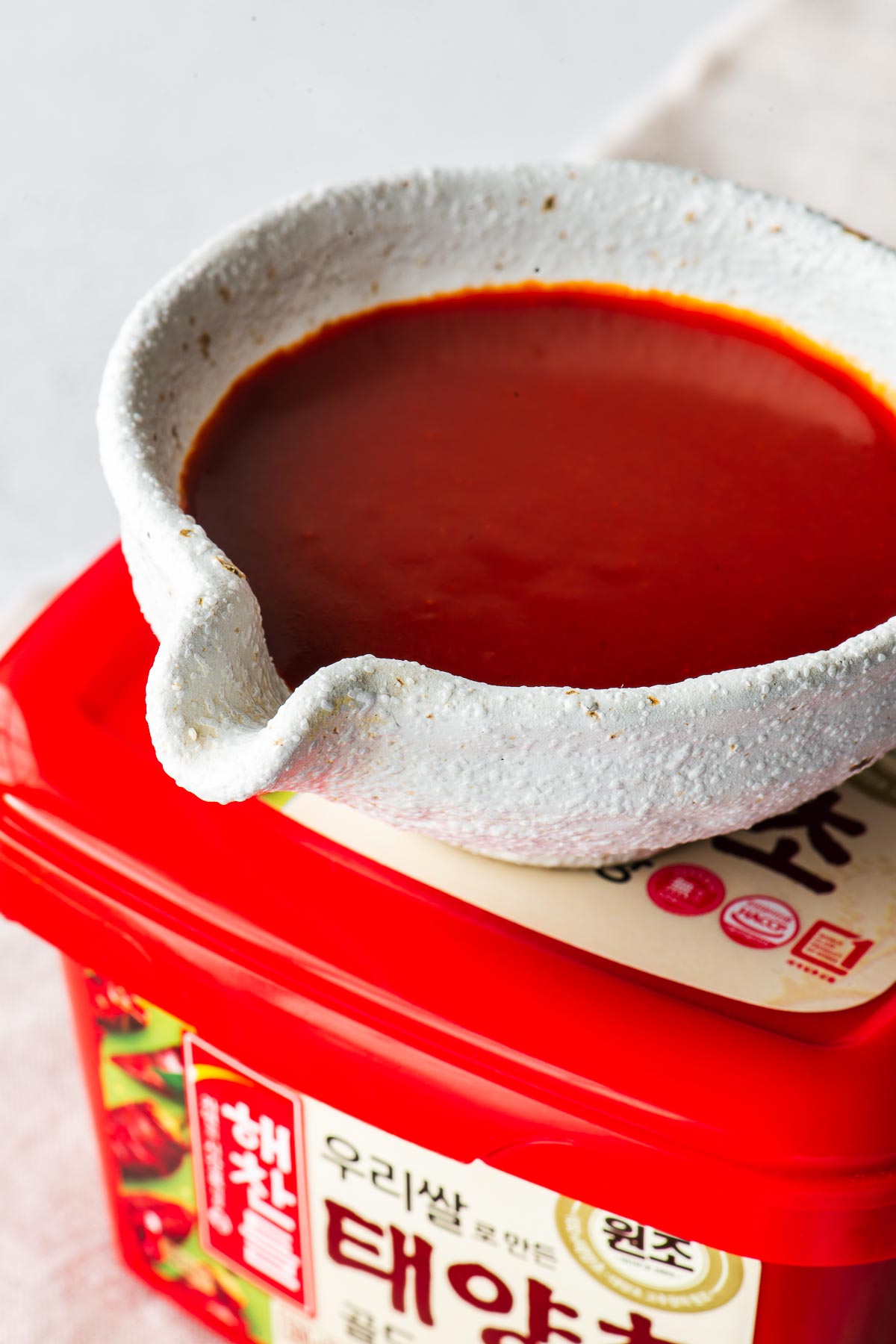
Ingredients & substitutes
- Gochujang paste: This spicy Korean red pepper paste is the key ingredient in my bibimbap sauce. It is vibrant red and umami-packed. You can find it at Asian grocery stores or in the Asian section of your local grocery store. If you struggle to track it down, try this gochujang substitute recipe.
- Toasted sesame oil: The oil adds a luscious texture and that distinct nutty flavour of toasted sesame seeds.
- Rice vinegar: Vinegar adds acidity to brighten up the spicy gochujang. I prefer plain rice vinegar (or rice wine vinegar – not to be confused with rice wine!). If you use seasoned rice vinegar, you can reduce the sweetener (maple syrup or sugar) in the sauce. You can also use apple cider vinegar if that is what you have.
- All-purpose soy sauce: You can also use light soy sauce, tamari, coconut aminos or sweet soy sauce (kecap manis), but avoid dark soy sauce. If you use sweet soy sauce, omit the maple syrup (or other sweetener of choice). You can also omit the all-purpose soy sauce and simply season the gochujang sauce with a pinch of salt.
- Maple syrup: Or use the same amount of brown rice syrup or honey. Otherwise, regular white or brown sugar will also do the trick.
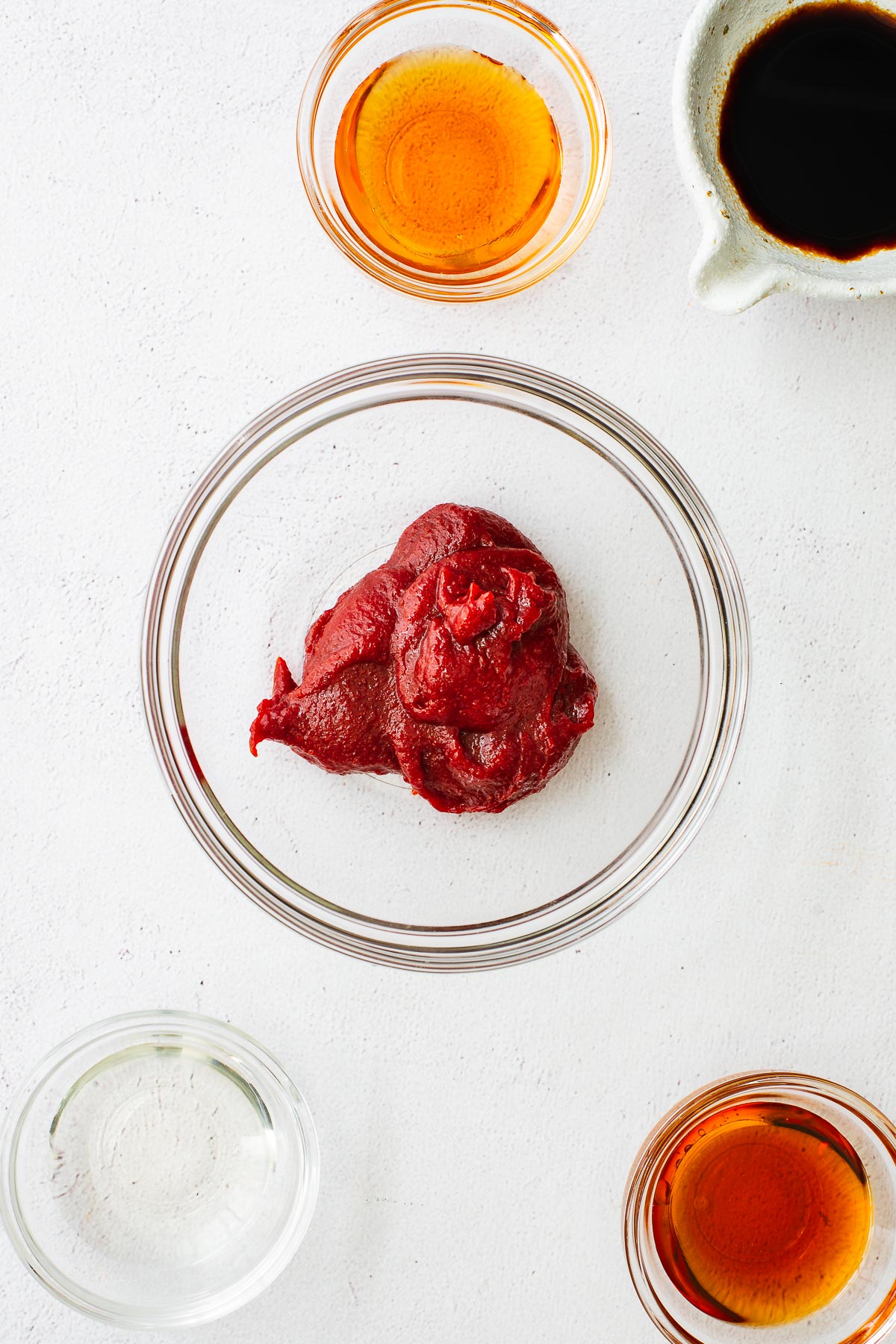
For non-spicy bibimbap sauce
If you are not into spicy food, try the doenjang version of bibimbap sauce. Substitute doenjang for gochujang in the recipe. And add a teaspoon of minced garlic. Continue with the recipe instructions.
Doenjang is a fermented bean paste, like a Korean miso paste. Japanese miso paste is very similar to doenjang (although miso is fungus fermented and doenjang with a bacterial culture). So, you can use miso paste instead of doenjang if that is what you have.
How to make bibimbap sauce
Making bibimbap sauce could not be simpler.
Place the gochujang, toasted sesame oil, rice vinegar, soy sauce and maple syrup in a small bowl and mix until blended.
If your sauce is very thick, add a splash of water to thin it to a pourable consistency.
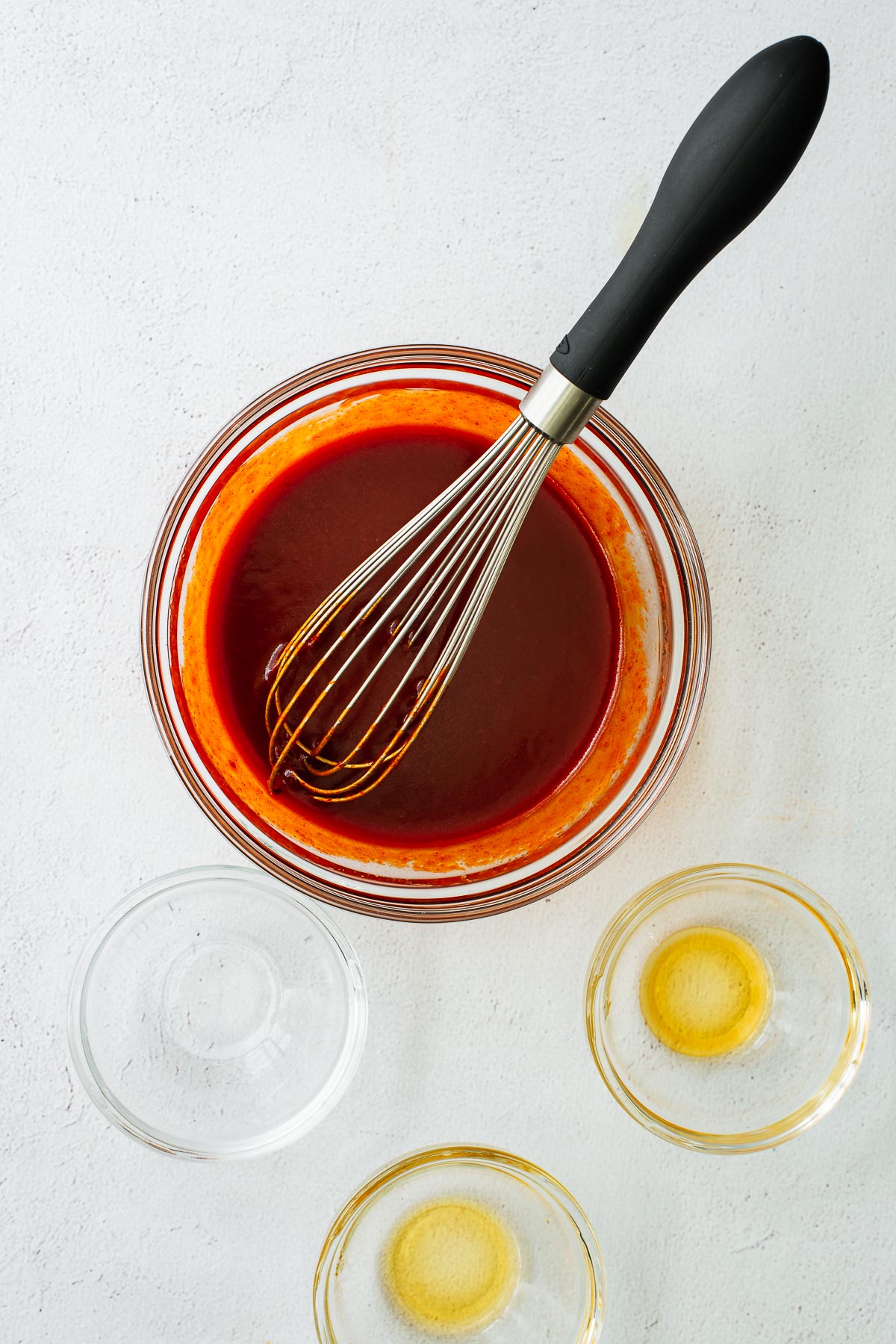
How to store bibimbap sauce
Make a large batch of sauce and store it in a squeaky clean, airtight container in the fridge. It keeps well for up to two weeks.
Your sauce may thicken in the fridge. Stir through a splash of water before serving to loosen the sauce.
Serving suggestions
You can use gochujang sauce as a spicy dipping sauce. Use it to top Buddha bowls, rice bowls or even noodles. Or spice up your next bowl of gyeran bap (Korean egg rice)
Though the ultimate use for gochujang sauce is homemade bibimbap. There are three essential parts to any Korean bibimbap – rice, toppings (I keep mine veggie-based) and bibimbap sauce. The rest is up to you.
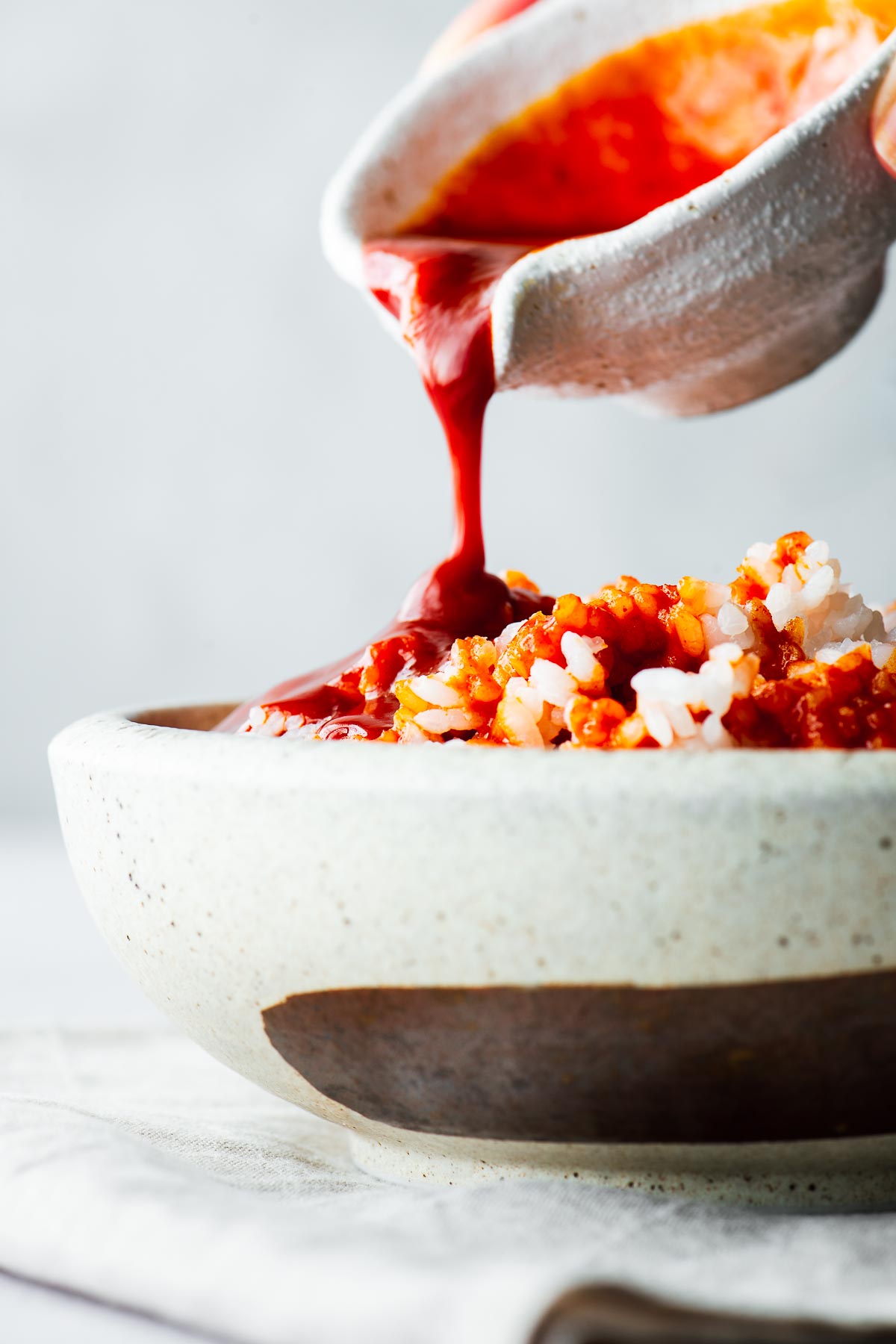
How to make a vegetarian bibimbap
Step 1: Start with a layer of cooked rice (sushi rice, glutinous rice, or any other short-grain rice).
See how to cook perfect sushi, short-grain or medium-grain rice in this easy stovetop sushi rice recipe or in this Instant Pot sushi rice recipe.
Step 2: Follow with your toppings.
Try grilled sweetcorn, shiitake mushrooms, thinly sliced sautéed zucchini (courgette), roasted broccoli or cauliflower, mangetout, soybean sprouts, green onion or kimchi, and top it with a fried egg.
Though untraditional, you can even add avocado as Meera Sodha does in her “Sweet potato and tenderstem bibimbap recipe”. It is in her cookbook, East.
Step 3: Finish the bibimbap bowl with a generous drizzle of gochujang sauce and toasted sesame seeds.
This Korean rice bowl allows for endless variations. For a vegan bibimbap bowl, omit the egg.
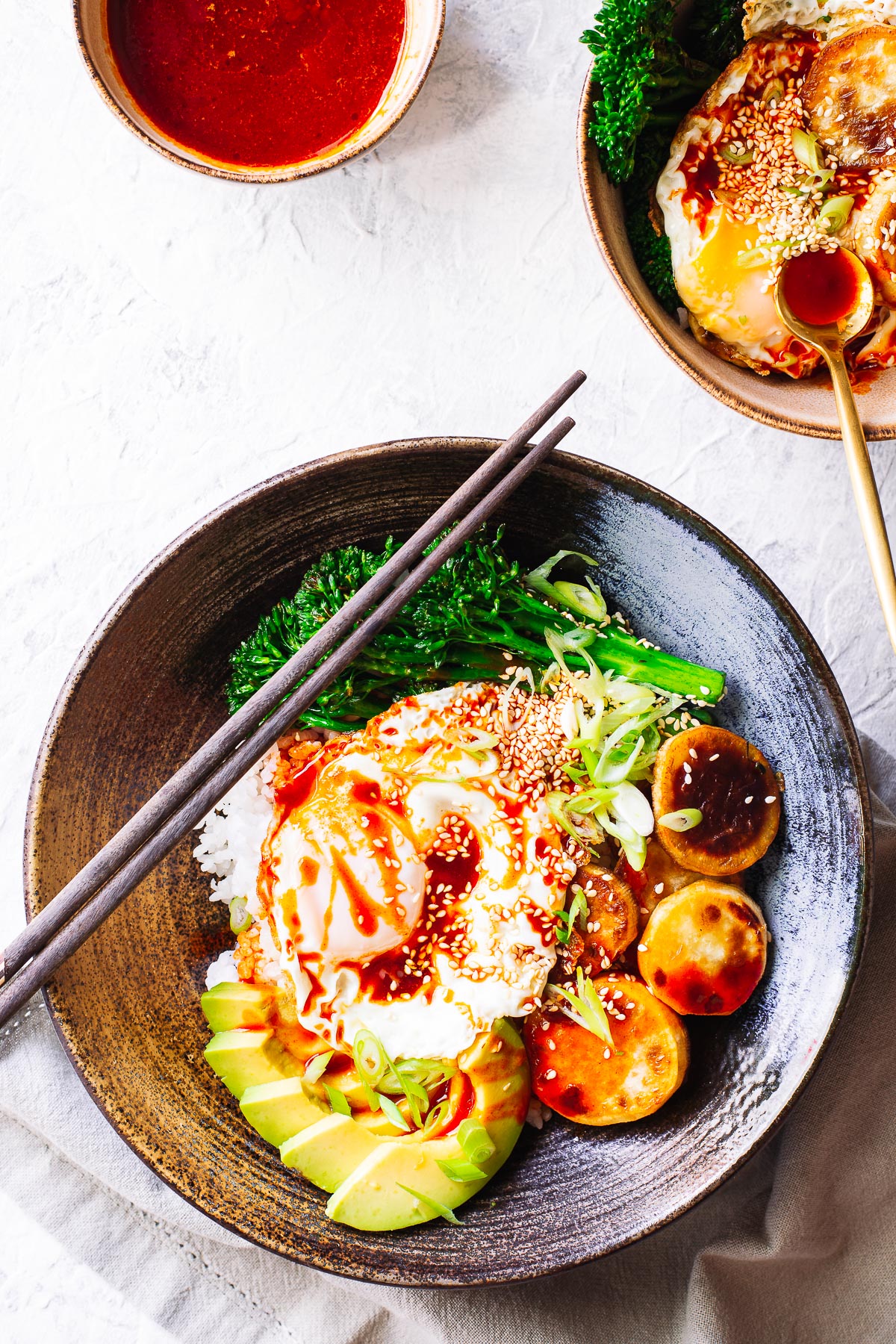
Make a large batch of the sauce and try different variations for your work lunch. It is also a great way to use up leftover cooked veggies and rice. You can serve it warm or at room temperature.
Use leftover bibimbap sauce and rice in your next gochujang fried rice with kimchi.
Frequently asked questions
Bibimbap sauce is typically made with a combination of gochujang (fermented hot pepper paste), sesame oil, sugar, garlic, and vinegar.
Bibimbap is a Korean dish composed of warm white rice topped with vegetables, beef, egg, and a spicy sauce. Bibim means “mixed” and bap means “rice”. Bibimbap is “mixed rice” because the rice, toppings, and sauce are mixed table side.
Bibimbap sauce accompanies Korean rice bowls (bibimbap). A key ingredient in popular bibimbap sauce is gochujang paste. Therefore, bibimbap sauce is also called “gochujang sauce for bibimbap“.
Gochujang is a fermented red chilli paste from Korea. It is the main ingredient in gochujang sauce. Gochujang sauce (bibimbap sauce) also contains a sweetener, sesame oil and rice vinegar (sometimes also garlic, sesame seeds or soy sauce).
Korean side dishes
Serve your bibimbap sauce with steamed rice and banchan (Korean side dishes) to assemble an easy bibimbap bowl:
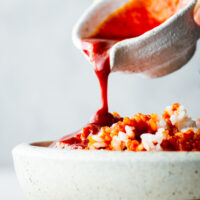
Ingredients
- ¼ cup gochujang paste
- 2 tablespoons toasted sesame oil
- 2 tablespoon maple syrup (or brown rice syrup, honey, or sugar)
- 1½ tablespoon rice vinegar
- 1 tablespoon soy sauce
Instructions
- Place all the ingredients in a small bowl and mix to combine. Add a splash of water if the sauce is too thick, it should be pourable.
- Transfer the gochujang sauce to an airtight container and refrigerate for up to two weeks, or use it immediately.
Notes
- Different gochujang paste brands can have different intensity and spiciness levels. So always taste and adjust your bibimbap sauce to suit your heat tolerance. For bibimbap, remember that the sauce accompanies lots of rice, so it must be intense.
- See ingredients for more details on ingredients and substitutes.
- Serve your bibimbap sauce over perfect steamed Instant Pot short-grain rice or easy stovetop short-grain rice.
Learn more about Korean ingredients:
